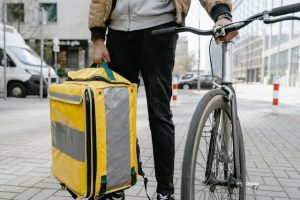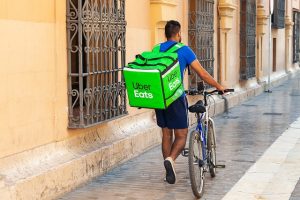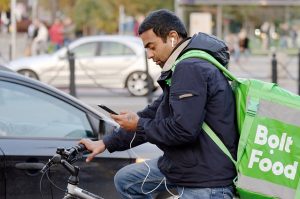In London, the buzz of motorcycles, the whirr of e-scooters, and the rhythmic pedalling of bicycles have become as familiar as the chimes of Big Ben.
These aren’t just sounds of modern city life; they represent the pulse of London’s growing gig economy.
But beneath the convenience of getting that late-night pizza delivered, or the speed of an express parcel, lies a complex safety issue for the workers powering these services.
1. The Rise of Two-Wheeled Deliveries

London has seen a sharp rise in the number of gig economy workers relying on two wheels to earn a living. With services like Deliveroo, Uber Eats, and Just Eat booming, an increasing number of people are zipping across the city, trying to navigate traffic, narrow streets, and the ever-present challenge of London’s unpredictable weather.
According to recent figures, over 140,000 people are estimated to be employed in delivery roles across the UK, with the majority relying on motorcycles, bicycles, or e-scooters. The demand for speed and convenience comes at a price – and often, it’s the giggers who end up paying.
2. The Safety Statistics
The numbers tell a troubling story. According to Transport for London (TfL), cyclists and motorcyclists account for almost half of all road traffic incidents in the city, despite making up a relatively small proportion of road users. In fact, a recent report found that motorcyclists are 57 times more likely to be involved in a fatal crash than car drivers, while cyclists face similar alarming risks on London’s congested roads. For gig workers whose livelihoods depend on their ability to get from A to B swiftly, these statistics are more than just numbers – they’re a daily reality.
3. Responsibilities of Platforms

Gig economy platforms, such as Deliveroo and Uber Eats, have transformed urban logistics, but with this transformation comes a responsibility that cannot be ignored. At present, many workers operate under a self-employed status, meaning they often lack access to the kinds of safety nets traditional employees might take for granted – including comprehensive insurance, paid sick leave, or training.
Platforms need to step up by providing training programmes, PPE (personal protective equipment), and most importantly, improved insurance coverage to mitigate the risks their riders face every day.
The recent introduction of kits with high-visibility vests and helmets is a step in the right direction. But is it enough? Many argue that true safety goes beyond gear – it’s about education, awareness, and ensuring that riders aren’t pressured into taking unnecessary risks just to meet unrealistic delivery times.
4. Insurance Gaps and Legal Considerations
One of the biggest issues facing gig workers is the gap in insurance coverage. While some platforms offer basic coverage for work-related injuries, the reality is that many riders lack comprehensive protection, leaving them vulnerable in the event of an accident.
Given the inherent risks associated with navigating London’s streets on two wheels, there’s a pressing need for better insurance options that cater specifically to the unique challenges faced by gig economy riders. Employers and platforms could lead the charge here, offering subsidised or mandatory insurance plans that truly protect their workforce.
5. How Employers and Workers Can Improve Safety

So, what can be done to improve the safety of these workers?
For the platforms, providing more realistic delivery expectations can significantly reduce the pressure on riders to rush – a common cause of accidents. Additionally, investing in regular training sessions to help riders stay updated on road best practices could make a real difference. Providing financial support for proper protective gear, like high-quality helmets and padded clothing, would also go a long way.
For the workers themselves, education is key. Riders should be encouraged to undergo cycling or motorcycling proficiency courses to sharpen their skills, especially for navigating a city as hectic as London with various types of vehicles about like pedicabs and more. Small measures, such as wearing bright, reflective clothing and making use of bike lanes wherever possible, can also enhance visibility and reduce the likelihood of incidents.
Moreover, motorcycle accident solicitors can be an essential resource for riders involved in accidents. They can help riders navigate the complex legal landscape, ensuring that they receive appropriate compensation for injuries sustained while working.
6. The Role of Policy and Infrastructure
London’s road infrastructure and government policy also play critical roles. While the introduction of more bike lanes in recent years has been a welcome development, many argue that these provisions are still inadequate for the growing number of riders. Creating safer road environments, expanding protected cycle lanes, and ensuring e-scooter trials are accompanied by strong safety protocols could all contribute to making the streets safer for those who keep London moving.
The convenience of on-demand delivery often obscures the realities faced by those who make it possible. For London’s workers on two wheels, the daily grind involves more than just delivering a meal or a package – it’s about navigating risks that most of us might not fully appreciate. By addressing insurance gaps, setting realistic delivery expectations, and investing in both training and infrastructure, platforms and policymakers alike have the power to protect those who help keep the capital connected. And for every Londoner who enjoys the convenience of a swift delivery, it’s worth remembering the human behind the handlebars.
Author Profile

- Online Media & PR Strategist
- As the Chief of Marketing at the digital marketing agency ClickDo Ltd I blog regularly about technology, education, lifestyle, business and many more topics.
Latest entries
 LifestyleApril 9, 2025Top 28 Hatton Garden Jewellers to Shop for the Best Jewellery
LifestyleApril 9, 2025Top 28 Hatton Garden Jewellers to Shop for the Best Jewellery Companies In LondonApril 9, 202510 Best Accounting Firms for Small Businesses in London
Companies In LondonApril 9, 202510 Best Accounting Firms for Small Businesses in London Business AdviceMarch 27, 20259 Ways Technology Helps Businesses Offer Better Promotions
Business AdviceMarch 27, 20259 Ways Technology Helps Businesses Offer Better Promotions Health & BeautyMarch 16, 2025Top 15 Dentists in London – Private Emergency Dentist
Health & BeautyMarch 16, 2025Top 15 Dentists in London – Private Emergency Dentist




